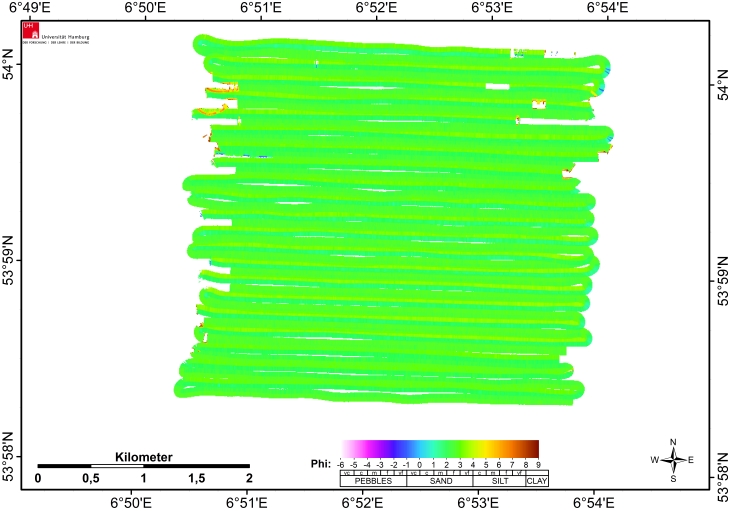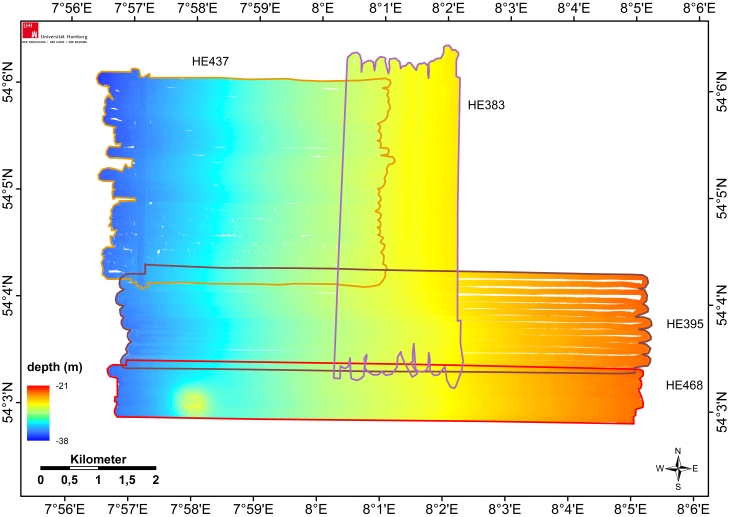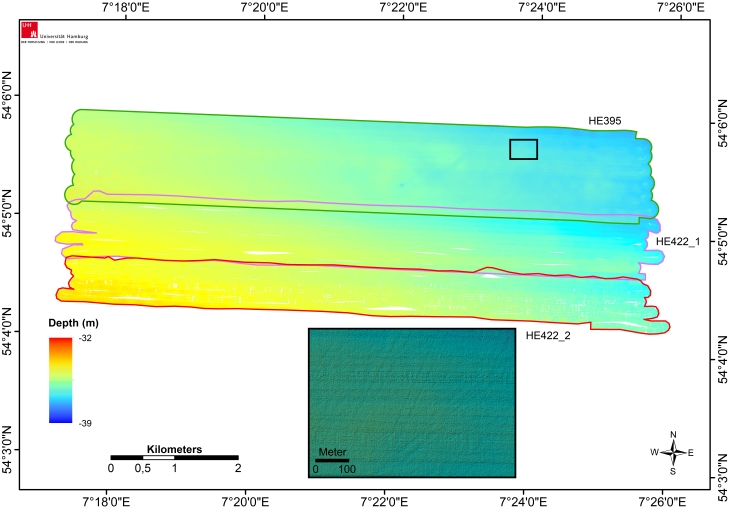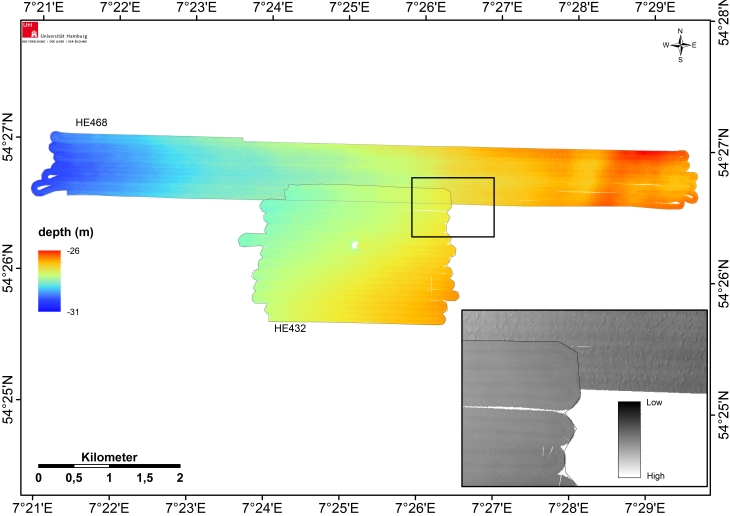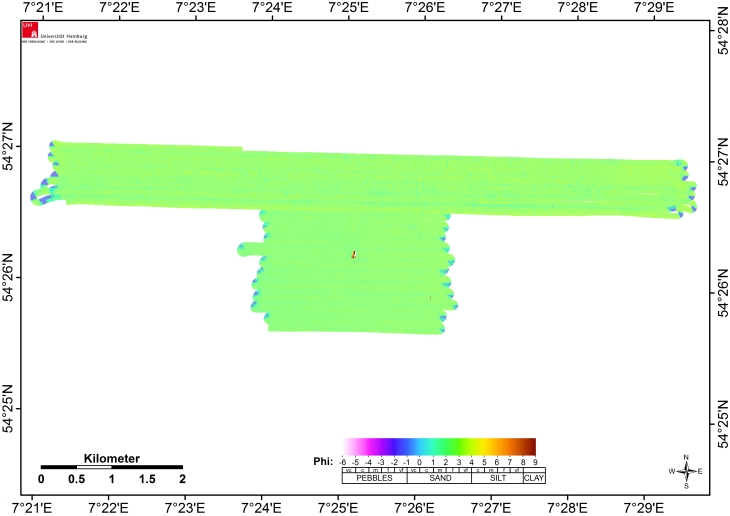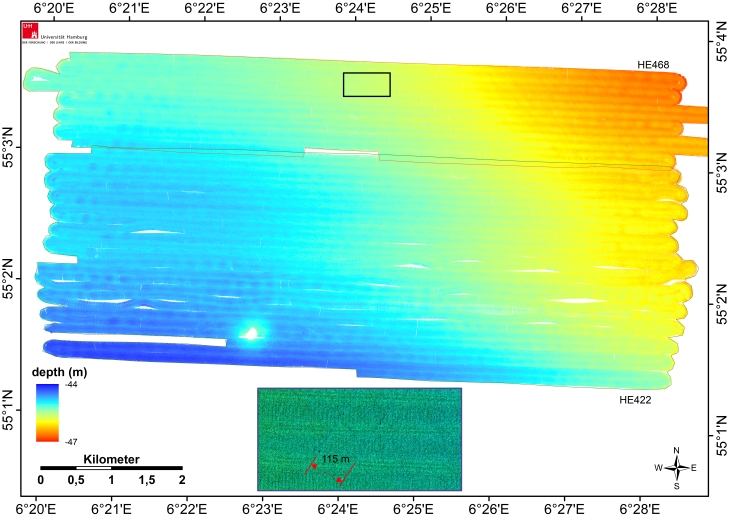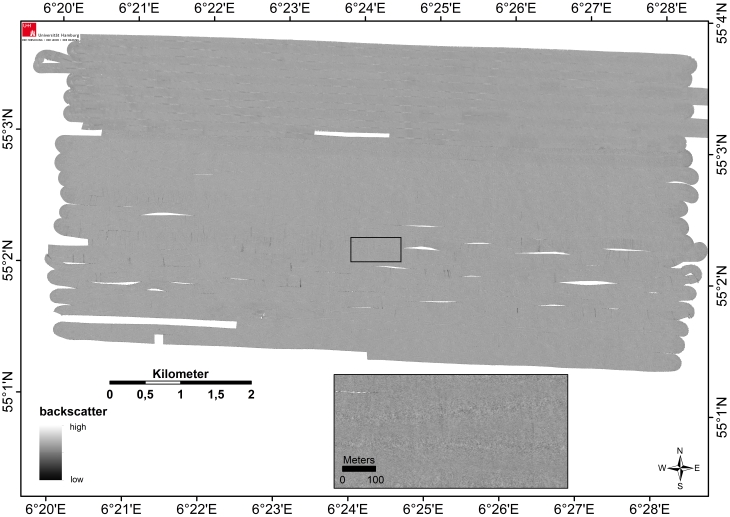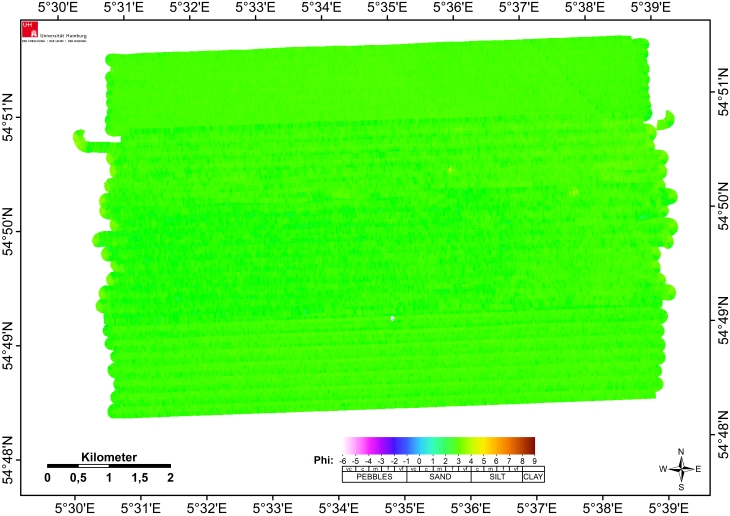Work Areas
NOAH area A is located on Borkum Riffgrund. The average water depth is about 31 m. The sea floor is uneven and characterized by patches of coarse sand and gravel covering a Pleistocene subsurface. Mud contents in the surficial deposits range between 0 and 8 % indicating the heterogeneity of surface sediments. The estimated content of organic carbon is about 0.05 %, which is the lowest value of all nine NOAH areas. Concentrations of organic pollutants (CHCs and PAHs) in total sediments are very low.
The average bottom temperature calculated for the period 1970-1999 is about 10.4 °C. Maximum and minimum bottom temperatures during this period are 19.9 °C and 0.25 °C, respectively. The near-bottom current velocity is characterized by the M2 tidal cycle. The mean current velocity 1 m above bottom for the period 1970-1999 is 33.3 cm/s. The maximum current velocity is 94 cm/s. Seasonal variations in current speed are low, indicating that wind induced currents play a minor role.
The diversity of benthic infauna and epifauna is generally low. The infauna community can be attributed to the Goniadella-Spisula community. The epifauna community can be attributed to a transitional epibenthic community between coast and Oysterground with high numbers of the seastar Asterias rubens, the swimming crab Liocarcinus holsatus and the shrimp Crangon crangon. The fishing pressure in NOAH area A is low. Swept area ratios (i.e., the mean number of times the seabed in the area was impacted by a fishing gear in one year) calculated for 2012 are below 0.0062 for all relevant bottom trawls.
NOAH area B is located on a level surface with a slight slope on the southern edge of the Pleistocene Elbe valley (Rinne). The water depth increases towards the Northeast and averages about 29 m. Surface sediment are described as "fine sand", with mud contents ranging between 0.31 and 13.5 %. The estimated content of organic carbon is about 0.08 %, in accordance with the low mud content. These characteristics also cause low concentrations of organic pollutants (CHCs and PAHs) in total sediments.
The average bottom temperature calculated for the period 1970-1999 is about 10.3 °C. Maximum and minimum bottom temperatures during this period are 21 °C and -0.58 °C, respectively. The near-bottom current velocity is characterized by the M2 tidal cycle. The mean current velocity 1 m above bottom for the period 1970-1999 is 33.2 cm/s. The maximum current velocity is 91 cm/s. Seasonal variations in current speed are low, indicating that wind induced currents play a minor role.
The diversity of benthic infauna and epifauna is generally low. The infauna community can be attributed to the Tellina-fabula community. The epifauna community corresponds to a transitional epibenthic community between coast and Oysterground with high numbers of the seastar Asterias rubens, the swimming crab Liocarcinus holsatus and the shrimp Crangon crangon. The fishing pressure in NOAH area B is comparatively low. Swept area ratios (i.e., the mean number of times the seabed in the area was impacted by a fishing gear in one year) calculated for 2012 amounts to 0.034. The total effort of small beam trawlers is negligible, but concentrated in the northern half of NOAH area B, due to higher fishing intensity in close proximity to the “plaice box”, a protected area from which trawlers with more than 221kW engine power are excluded.
NOAH area C is located between Helgoland and Scharhörn and has an average water depth of about 20 m. Influenced by the Helgoland mud area, which marks the entrance to the Pleistocene Elbe Rinne, mud and TOC contents in surface sediments are the highest of all NOAH areas, reaching up to 79 % and 0.83 %, respectively. The disposal of effluent sludges in the sourrounding region has led to very high, but spatially varying concentrations of organic pollutants in NOAH area C.
NOAH area C is the most distinct "coastal" site among the nine NOAH areas and thus shows the highest variation in bottom temperatures due to the stronger influence of the continental land mass. The average bottom temperature calculated for the period 1970-1999 is about 10.3 °C. Maximum and minimum bottom temperatures during this period are 21 °C and -0.58 °C, respectively. The near-bottom current velocity is characterized by the M2 tidal cycle, and among the strongest of all NOAH areas. The mean current velocity 1 m above bottom for the period 1970-1999 is 35.3 cm/s. The maximum current velocity is 90 cm/s. Seasonal variations in current speed are low, indicating that wind induced currents play a minor role.
The diversity of benthic infauna and epifauna is generally low, while seasonal variability of species abundance, diversity and community structure is quite high. The infauna community can be attributed to the Nucula-nitidosa community. The epifauna community is a typical coastal assemblage with high numbers of the seastar Asterias rubens, the swimming crab Liocarcinus holsatus and the shrimp Crangon crangon.
NOAH area C is located within the “plaice box”, an area protected from trawlers with engines larger than 221kW. Consequently, the impact on the seafloor by bottom trawling is very low. Swept area ratios (i.e., the mean number of times the seabed in the area was impacted by a fishing gear in one year) calculated for 2012 amounts to 0.007.
NOAH area D is located in the Pleistocene Elbe Rinne. The average water depth is about 35 m. Mud contents range between 6 and 21 %. The estimated TOC content is about 0.2 %. These values are slightly higher than in the NOAH area B close by, indicating better conditions for fine sediment accumulation. As expected, this conditions also lead to intermediate concentrations of organic pollutants (CHCs and PAHs) in total sediments.
The average bottom temperature calculated for the period 1970-1999 is about 10.2 °C. Maximum and minimum bottom temperatures during this period are 20.5 °C and -0.24 °C, respectively. The near-bottom current velocity is characterized by the M2 tidal cycle. The mean current velocity 1 m above bottom for the period 1970-1999 is 31.8 cm/s. The maximum current velocity is 77 cm/s. Seasonal variations in current speed are low, indicating that wind induced currents play a minor role.
The diversity of benthic infauna and epifauna is generally low, while seasonal variability of species abundance, diversity and community structure is quite high. The infauna community can be attributed to the Nucula-nitidosa community. The epifauna community is transitional between the coast and the Oysterground with high numbers of the seastar Asterias rubens, the swimming crab Liocarcinus holsatus and the shrimps Crangon crangon and Crangon allmanni. NOAH area D has the highest fishing intensity of large beam trawlers of all nine NOAH areas. The estimated swept are ratio (i.e., the mean number of times the seabed in the area was impacted by a fishing gear in one year) in 2012 is about 0.53. Accordingly, more than half the size of area D is trawled each year.
NOAH area E is located on the so-called "Sylter Aussenriff" which is characterized by a rough sea floor that comprises a sandy and gravelly plain between the Pleistocene Elbe Rinne and the Schleswig-Holstein Wadden Sea. The average water depth is about 28 m. Mud contents are very low, ranging between 0.04 and 1.2 %. The estimated TOC content of about 0.06 % is typical for sandy sediments. These characteristics also cause low concentration of organic pollutants (CHCs and PAHs) in total sediments.
The average bottom temperature calculated for the period 1970-1999 is about 10.1 °C. Maximum and minimum bottom temperatures during this period are 20.1 °C and -0.18 °C, respectively. The near-bottom current velocity is characterized by the M2 tidal cycle. The mean current velocity 1 m above bottom for the period 1970-1999 is 29.3 cm/s. The maximum current velocity is 65 cm/s. Seasonal variations in current speed are low, indicating that wind induced currents play a minor role.
The diversity of benthic infauna and epifauna is generally low. The infauna community can be attributed to the Tellina-fabula community. Sandlicker, suspension feeder, interface and surface deposit feeder are the dominant feeding types. The epifauna community is transitional between coast and Oysterground with high numbers of the seastar Asterias rubens, the swimming crab Liocarcinus holsatus and the shrimp Crangon crangon. In NOAH area E, only small beam trawlers operate, but quite intensely. The estimated swept area ratio (i.e., the mean number of times the seabed in the area was impacted by a fishing gear in one year) in 2012 is about 0.24. This means that an area close to one quarter of the size of area E was trawled over one year.
NOAH area F is located in the transition zone between Pleistocene Elbe Rinne and Oyster Ground. The area is characterized by a smooth sea floor with homogeneous surface sediments. The average water depth is about 40 m. Mud contents range between 3.4 and 16 %, while the estimated average TOC content reaches about 0.2 %. Moderate concentrations of organic pollutants (CHCs) and higher PAH concentrations are due to enhanced combustion residues and PAH emissions from the nearby main shipping routes.
The average bottom temperature calculated for the period 1970-1999 is about 10 °C. Maximum and minimum bottom temperatures during this period are 18.9 °C and 0.86 °C, respectively. The near-bottom current velocity is characterized by the M2 tidal cycle. The mean current velocity 1 m above bottom for the period 1970-1999 is 24.5 cm/s. The maximum current velocity is 65 cm/s. Seasonal variations in current speed are low, indicating that wind induced currents play a minor role.
The diversity of benthic infauna and epifauna is higher here than in the coastal areas. The infauna community is characteristic of a transitional zone between the Amphiura filiformis and the Nucula-nitidosa communities. be attributed to the Tellina-fabula community. Interface- and surface-deposit feeder are the dominant feeding types. The epifauna community can be attributed to a Oysterground community with high numbers of the swimming crab Liocarcinus holsatus, and the seastars Asterias rubens and Astropecten irregularis. In NOAH area F, large beam trawlers (>221kW engine power) targeting flatfish represent the main fishing segment. The estimated swept are ratio (i.e., the mean number of times the seabed in the area was impacted by a fishing gear in one year) in 2012 amounts to 0.32. This means that an area of the size of about one third of area F is trawled per year.
NOAH area G is located in the northern part of the Pleistocene Elbe Rinne. It is characterized by a smooth sea floor with homogeneous surface sediments. The average water depth is about 46 m. In comparison to the other NOAH areas, mud and TOC contents are relatively high, reaching up to 35 % and 0.4 %, respectively.
The average bottom temperature calculated for the period 1970-1999 is about 9.6 °C. Maximum and minimum bottom temperatures during this period are 18.3 °C and 1 °C, respectively. The near-bottom current velocity is characterized by the M2 tidal cycle. The mean current velocity 1 m above bottom for the period 1970-1999 is 19.9 cm/s. The maximum current velocity is 61 cm/s. A difference of more than 10 cm/sec between maximum currents in summer and winter shows that wind induced currents are more important in this NOAH area. However, the current regime is still primarily determined by tidal forces.
The diversity of benthic infauna and epifauna is higher than at coastal sites. The infauna community can be attributed to the Amphiura-filliformis community. Interface- and surface-deposit feeder are the dominant feeding types. The epifauna community corrsponds to a special Oysterground community with Nephrops norwegicus, Liocarcinus holsatus and Brissopsis lyrifera as characteristic epibenthic species. The angular crab Goneplax rhomboides recently shifted its distribution range from the north-eastern Atlantic to the North Sea and is frequently found in this NOAH area G. In NOAH area G, otter trawling is more important than beam trawling. The swept area ratio (i.e., the mean number of times the seabed in the area was impacted by a fishing gear in one year) in 2012 amounts to 0.55. This means that an area of more than half the size of area G is trawled per year.
NOAH area H is located in proximity to the eastern Oyster Grounds and has an average water depth of about 42 m. Mud contents between 2 and 9 % are clearly lower than at the other "deep water” sites of NOAH areas F and G. The estimated average TOC content is about 0.2 %. TOC measurements in close vicinity to NOAH area H indicate that this estimated value may be too high. Concentrations of organic pollutants (CHCs and PAHs) in total sediments are very low.
The average bottom temperature calculated for the period 1970-1999 is about 9.6 °C. Maximum and minimum bottom temperatures during this period are 17.9 °C and 1.4 °C, respectively. The near-bottom current velocity is characterized by the M2 tidal cycle. The mean current velocity 1 m above bottom for the period 1970-1999 is 18.1 cm/s. The maximum current velocity is 54 cm/s. A difference of more than 9 cm/sec between maximum currents in summer and winter shows that wind induced currents are important in NOAH area H. However, the current regime is still primarily determined by tidal forces.
The diversity of benthic infauna and epifauna is higher as compared to the coastal areas. The infauna community can be attributed to the Amphiura-filliformis community. Interface- and surface-deposit feeder are the dominant feeding types. The epifauna community corresponds to a special Oysterground community with Nephrops norwegicus, Liocarcinus holsatus and Brissopsis lyrifera as characteristic epibenthic species. Seasonal variability of species abundance, diversity and community structure is evident, but less pronounced as compared to coastal areas. In NOAH area H, otter trawling is more important than beam trawling. The swept area ratio (i.e., the mean number of times the seabed in the area was impacted by a fishing gear in one year) in 2012 amounts to 0.27. This means that an area of about one quarter the size of area H is trawled per year.
NOAH area I is located in the north-eastern part of Dogger Bank where the average water depth is about 30 m. Mud contents range between 0.07 and 0.8 % and are among the lowest of all nine NOAH areas. The estimated average TOC content in this sandy area is about 0.08 %. This is comparable to the TOC contents in the sandy NOAH areas A, B and E. Accordingly, the concentration of organic pollutants (CHCs and PAHs) in total sediments are also very low.
NOAH area I is the most distinct "open sea" site among the nine NOAH areas, showing the lowest variation in bottom temperatures. The average bottom temperature calculated for the period 1970-1999 is about 9.5 °C. Maximum and minimum bottom temperatures during this period are 17.4 °C and 1.9 °C, respectively. The near-bottom current velocity in NOAH area I is governed by tidal currents as well as by wind-induced currents. The mean current velocity 1 m above bottom for the period 1970-1999 is 16.6 cm/s. The maximum current velocity is 73 cm/s. With respect to near-bed currents, a ratio of more than 4 between maximum and mean velocities classifies NOAH area I as the only "open sea area" of all nine NOAH areas.
The diversity of benthic infauna and epifauna is high compared to the coastal areas. The infauna community can be attributed to the Bathyporeia elegans-Tellina fabula community. Sand-licker, interface- and surface deposit-feeder were the dominat feeding types. The epifauna community corresponds to the Duck`s Bill community with high numbers of the swimming crab Liocarcinus holsatus, the seastars Asterias rubens and the hermit crab Pagurus bernhardus. Special faunal elements such as sponges, ascidians, the sea star Luidia sarsi or the whelk Buccinum undatum are also frequently found. Abundance and biomass of epibenthic species is highest in winter and lowest in summer in that area, which a pattern opposite to that of coastal communities. In NOAH area I, large beam trawlers (>221kW engine power) targeting flatfish represent the main fishing segment. The swept area ratio (i.e., the mean number of times the seabed in the area was impacted by a fishing gear in one year) in 2012 amounts to 0.33. This means that an area of about one third the size of area I is trawled per year.
Underwater tour through the German North Sea








